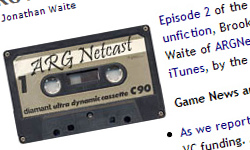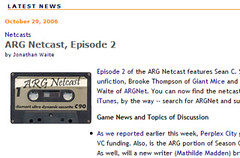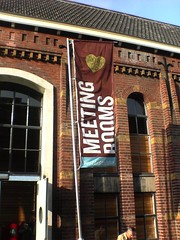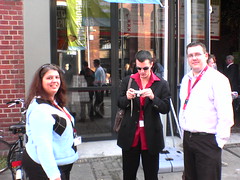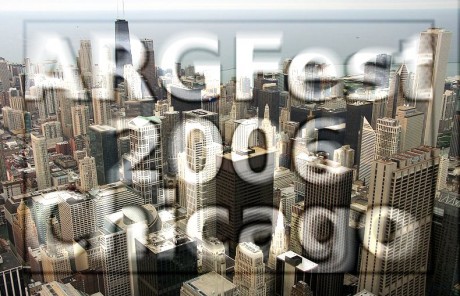[box type=“info“] Dieser Artikel ist ein Crossposting von www.transmedia-storytelling-berlin.de. Zur Zeit wird an der Seite jedoch noch fleissig gearbeitet, sodass sie vorraussichtlich ab dem kommenden Montag (29.08.2011) mit all ihren Informationen öffentlich zugänglich sein wird.[/box]
Jeder von uns trägt ein kleines Universum in sich, das manchmal auf den richtigen Auslöser wartet. Hin und wieder reicht schon ein bisschen Kometen-Staub aus, an anderen Tagen müssen erst zwei Sterne aufeinander treffen um sich zu vereinen und die Geschichte des Universums freizugeben.

So gibt es seit der Entwicklung der Sprache Menschen, die es schaffen, ihr kleines Geschichten-Universum anderen zugänglich zu machen. Die Gebrüder Jacob und Wilhelm Grimm forschten schon um 1806 auf dem Gebiet des Geschichten-Erzählens. Sie zogen dafür durch das Land, ließen sich die verschiedensten Geschichten erzählen und fassten diese in ihrem Werk „Märchen und Sagen“ zusammen.
Die auf das Papier gedruckten Worte verzückten bereits damals den einen oder anderen Leser. Seitdem hat sich die Tradition und die Berufung des Geschichten-Erzählers weiter entwickelt. Heute wird eine Geschichte nicht mehr nur über ein Medium erzählt sondern über mehrere. Die Medien sind dabei eine Art Vehikel, die ihrerseits die Bühne der Geschichte bereiten. Sie werden zum Teil des Universums, in dem die Geschichte erfahren werden kann.
Transmedia Storytelling Definitionen
Henry Jenkins fasst das bereits im Jahr 2007 in einem Artikel seines Blogs „Confessions of an ACA-Fan“ wie folgt zusammen:
[learn_more caption=“Transmedia Storytelling 101″ state=“open“] „Transmedia storytelling represents a process where integral elements of a fiction get dispersed systematically across multiple delivery channels for the purpose of creating a unified and coordinated entertainment experience. Ideally, each medium makes it own unique contribution to the unfolding of the story.“
– Henry Jenkins[/learn_more]
Der Begriff Transmedia Storytelling wurde bereits zum Ende des alten Jahrtausends geprägt, aber damals wurde die Diskussion nie öffentlich weitergeführt. Erst als Henry Jenkins 2003 seinen gleichnamigen Artikel in der Technology Review veröffentlichte, änderte sich dieser „Schwebezustand“ des Begriffes. Trotzdem dauerte es fast ein weiteres Jahrzehnt, bis der Begriff als feste Größe zum Beispiel auch von der Producers Guild of America anerkannt wurde. An diesem Durchbruch ist neben vielen anderen auch Jeff Gomez (Starlight Runner) beteiligt gewesen.
Trotzdem sind wir hier noch lange nicht am Ende der Definition und damit der Diskussion über Transmedia Storytelling angekommen. Es gibt noch viele offene Fragen und natürlich muss die Definition einer großen, angesehenen Organisation wie der PGA nicht unbedingt das glänzende Gold sein, nach dem alle streben.
Brian Clark von den GMD-Studios fasst in einem ausführlichen Facebook-Artikel und nach vielen Diskussionen seine Eindrücke der Definition der PGA und ihre Auswirkungen so zusammen:
[learn_more caption=“Reclaiming Transmedia Storyteller“]In any field, practitioners develop a specialized jargon that conveys either the complex nuance or razor specificity necessary for people to talk about what they do with each other. It is good for everyone to be involved in the debates about those kinds of terms of art on at least some level, as the dialog advances new ways of thinking about the work you should also be buried in.
At this phase in my career, I’m less interested in the Platonic ideas of what the labels should be, and far more interested in discussing why we’re suddenly having a hard time having a discussion as a community of practitioners and creators. We need to be able to discuss this without people taking that as a rebuke of their work or, conversely, worrying more about their own promotional positioning than the health of the movement.
That’s also why I decided to publish this on Facebook of all places: to remind us that we’re friends and peers who know each other: that’s why the discussion is worth having and why we should be capable of having it. Tag the people you talk about and reference to remind yourself of that: discover some new people in your community you didn’t know from those tags. Embrace that we’re not faceless board handles, we’re flesh and blood and full of passion and complex ideas and clumsy words.
Because not everyone is entering the conversation with the same personal experiences, I feel the need to set the stage and explain how I think this tension has emerged over the last few years
JENKINS AND THE UNFINISHED DEFINITION
The seeds of this gulf were sown by Henry Jenkins, who was largely responsible for the current popularity of the term „transmedia“: many of us have been friendly critics of the term since the beginning, but as an academian Henry has always encouraged that debate and been clear that the definition was an emerging thing. At Futures of Entertainment 4 at M.I.T. I was on a panel right after Henry where they asked us to react to his presentation, and I remember saying that it seemed like I was interested in optimizing exactly the opposite factors as Henry. The tensions of ideas advanced discussions.
My community of creative peers and I found something fascinating about the discourse around the term (a discourse we were dragged into by having our work labeled posthumously as transmedia). Transmedia instead of multimedia implied a distinction of creation that we also tried to highlight, and Henry’s focus on „it isn’t just adaptation“ and „it is an adjective that describes something else“ were appealing new distinctions that added to the conversation.
PGA CREDIT
The tone of that conversation began to sour after Jeff Gomez worked to establish a „transmedia producers credit“ at the Producer’s Guild of America, which cemented a definition of qualifying work that is confusing at best and exclusionary at worst. One of its core flaws (IMHO) is that it abandons Jenkin’s distinction of „it isn’t just adaptation“ – in fact, the credit definition talks about „3 or more storylines“ because in the Hollywood system, the transmedia is almost always a bolt-on adaptation of a primary IP that the producers don’t get to influence. I understand why it is what it is, and in general don’t find it massively relevant (it’s the requirements to get into PGA, not to be a transmedia producer), but it has sparked passions.
More worrisome to me is that the proponents of the PGA credit haven’t reacted to the criticism the way Henry did: they have intertwined their professional ambitions with the PGA definitions in a way that treats that discourse as inappropriate criticism, which turns friendly criticism into something less friendly. After mentioning the growing issue on this in passing in the comedic setup of my presentation at Power to Pixel, I was shocked by how defensive the tone of PGA credit defenders were – I was literally asked, „So, do you not want transmedia producers to have health insurance?“
#ANTITRANSMEDIA
Of course, that doesn’t stop the community of discourse. Steve Peters started the trend of mocking the label on Twitter with the #antitransmedia hashtag and the simple reminders like „bacon is the new transmedia.“ It became a template for criticism of speeches and blog posts about the topic that gained steam. As that dialog broadened, though, I began to realize that many of us were using that meme for totally different reasons.
Steve wanted to kill the label transmedia, in part because he feels that PGA credit definition is too restrictive. I, on the other hand, was really attacking the self-proclaimed gurus to point out how the phrase might have already become the new „viral“ (and if you asked my personal opinion on the PGA credit I’d either describe it as irrelevant or not restrictive enough.) Others were probably just in it for the lulz. It was perceived, though, as a „backlash from veteran transmedia creators“.
It eventually became just that when Brooke Thompson published a series of blog posts that sharpened the knife to the conversation provoked by the PGA credit definition. Comments became emails, emails became phone calls and the cross-fertilizing of ideas that always emerges from a good community of discourse started to happen.
EAST COAST / WEST COAST TRANSMEDIA
At the same time, I’d been spending a lot of time thinking about this division through the lens of my long relationship with the independent film community and saw many similarities. In conversations, I started calling it East Coast and West Coast and pointing out that maybe transmedia was salvageable if it was a big enough bucket to include two radically different visions of what it was about instead of all agreeing to do it just one way.
The West Coast transmedia tradition is largely what Jenkins was studying, and that style might be best personified by people like Elan Lee, Jordan Weisman and Jeff Gomez. It thinks more in terms of franchises, it has struggles with the relationships with the owners of the industry, and starts from the perspective that creators won’t own the IP they are creating. They want to fix the studio system, or recreate a new kind of studio.
The East Coast transmedia tradition is quite different and emerges far more from the independent traditions of media through people like Lance Weiler, Michael Monello, and I. It thinks in terms of one story told across platforms, it has struggles with monetizing and financing, and starts from the perspective that creators own the IP they are creating. They want to extend an existing community into transmedia, or recreate a new kind of community.
Neither is wrong. Few practitioners or creators work exclusively in one sphere or the other. One is not more noble or pure or profitable than the other. But we’re all guilty of conflating the two together in ways that lead to moments where it might sound like the community is, for example, telling documentary filmmakers that they need to think more like franchisers if they want to get on the transmedia bandwagon and not be left behind as „storytelling changes forever.“
As much as I would have loved to be the Biggie to someone else’s Tupac, conversations with Monello in the wake of Brooke’s blog posts put a finer knife on our argument if we didn’t want to just recreate the indie / Hollywood divide all over again. So the two of us hatched a potentially meaningful new way to talk about these issues … a way that also leads to some really controversial debates we hope to spark.
THE TENSION BETWEEN CREATING AND OWNING
The indie / Hollywood and divisions are just two potential configurations of the relationship between creating something and owning something – there are dozens others for just a handful of industries off the top of my head. When we as practitioners assume that everyone else is caught in or aspires to that same model of creation/owning we hit dangerous soggy ground that creates divisions.
Mike and I talked about all the different configurations suggested just by our own two resumes of work. As creators and entrepreneurs, we understand that there’s a difference in our entire approach when we’re one of the primary storytellers of the IP like „Blair Witch“ or „Nothing So Strange“ — we’re shaping our own stories to live through multiple ways of interacting with them. When we’re not the primary storytellers, when we’re given a smaller bucket that we’re allowed to work in and charged with some other goal like marketing, we might use the same production strategies but definitely not the same storytelling strategies.
It is a re-emphasis on what many of us thought the „trans“ in transmedia was trying to convey, based upon the dialogs that Henry Jenkins had sparked – that the act of telling a story through multiple media (especially with the addition of interactive media) was inherently different than the old models of thinking about storytelling like adaptation and extension.
TRANSMEDIA STORYTELLING VERSUS ITS METHODS
Mike and I found it useful to start talking about „transmedia storytelling“ as the label for when you’re creating a story as the primary storytellers and intending to tell your story across multiple channels. In the same way people might come to Mike or I because we have experience in some particular discipline (like publishing or filmmaking), they might also come to us to tap our experience as transmedia storytellers. When they do, but we’re not among the primary storytellers, then we’re showing them how to utilize the methods of transmedia storytelling (in the same way we might show them the methods of filmmaking or the methods of publishing.)
Here’s what gets me excited about this distinction: it illuminates what we have in common by looking at the different ways we work by separating the issue of creative control from the issue of ownership. Mike didn’t cease to be the transmedia storyteller of „Blair Witch“ when the sold the rights to Artisan, because he was still among the primary storytellers with creative control. Conversely, Gregg Hale and David Goyer were definitely transmedia storytellers of „Freakylinks“ even though it was a Fox Television production … up until the moment they lost control of the television show (then they were just using the methods.)
Sometimes that knife also cuts in surprising ways that we think raise interesting debates that we haven’t fully explored yet. For example: if you’re working for an entertainment IP you’ll tend to have less creative control than if you work for a non-IP brand. Mike and I think, for example, that „The Art of the Heist“ represents transmedia storytelling and not just its methods, even though it was a work-for-hire creation at an ad agency’s request. Audi didn’t have an existing IP that it was asking to have adapted or extended, it was asking for a new story utilizing multiple channels and we were among the central group of storytellers creating that.
We aren’t just inventing this from whole cloth, either: those of you that have had any art theory will recognize the same distinction as „art versus craft,“ which has been deeply useful for creators in every other form for discussing the act of creation.
THE CONTROVERSAL PILEMAKING
Mike and I realized that this debate got even more interesting if we started it by pointing at our own work that we could say, „this is not transmedia storytelling,“ because you could then say, „and by extension it means all these other things I didn’t make also aren’t transmedia storytelling“. Mike and I can both point to huge chunks of our resumes that are „marketing utilizing transmedia methods“ (as an example) that we’re quite proud of even though we weren’t „transmedia storytellers“, so we don’t propose these labels as value judgments, just as an important distinction that can be added to the debate.
One example from Mike: Campfire’s campaign for HBO’s „Game of Thrones“ is not transmedia storytelling, it is marketing utilizing transmedia methods. The original storyteller of the book that HBO is adapting has strict limits on what that adaptation can do: the IP restrictions mean you can’t just tell new stories set in that universe, because you’re not part of the primary storytelling team (or if you can, the stories are „non-canon“ in the context of the main story.) Not your story, you’re not the storyteller. So by extension, „Why So Serious?“ is also not transmedia storytelling, it is marketing utilizing transmedia methods for a film adaptation of the original storyteller’s IP (a comic book). Similarly, you can argue that „Star Wars“ is not transmedia storytelling; it is franchising utilizing transmedia methods (since the „canon“ of the six films cannot be violated by the extended universe, but the extended universe might conflict with each other or be rewritten by future canon.)
The construct is also useful for asking, „Who was the storyteller, and were they a transmedia storyteller?“ From the above examples, could you call David Goyer and Chris Nolan the transmedia storytellers of „The Dark Knight“ that „Why So Serious?“ is one part of? Did George Lucas become a transmedia storyteller with „Star Wars“ or is a better label something like „transmedia franchiser“? Is Steve Coulson a transmedia storyteller on „Game of Thrones,“ or is he a „transmedia marketer“?
CREATIVE CONTROL IS THE ISSUE
Whether you’re practicing East Coast or West Coast transmedia, the issue is about creative control: if you don’t have control over the design of the story and its distribution channels, you’re simply not able to reach that higher bar of telling that one story across numerous channels and you’re back to extending or adapting. You’re not a transmedia storyteller, you’re doing something else while utilizing the methods of transmedia. This is a common dilemma for creative professionals, and there’s all kinds of strategies for maximizing creative control in different industries that are adopting parts of the palate that was created by transmedia storytellers. Both the spread of adoption and the innovation of multiple valid paths for cultivating creative control are desired outcomes for everyone involved in this debate.
If creative control is the unifying goal, then we should reserve the phrases „transmedia story“ and „transmedia storyteller“ to when it passes some tipping point towards having an important creative voice in the core story rather than just when someone has helped adapt or extend someone else’s story onto a new platform. And I say that as someone who frequently is adapting or extending someone else’s story … or whispering in the ear of the primary storytellers about the things they could do as storytellers beyond just extending and adapting.
THE NEED FOR DEBATE
This piece is already too long, but I feel like I’ve only just scratched the surface of the conversations I’ve been a part of recently and would like to have more broadly. So Mike and I have made the commitment to push this debate forward, not just informally and in the digital space, but as the thrust of a crystalizing debate in our conference presentations. It provokes the right questions that lurk beneath the surface of the divide growing among us, re-hinges it against Henry Jenkin’s original provocations, and (frankly) makes the usefulness of transmedia methods much easier to understand for our friends and collaborators focused on the beautiful expressions of some other medium with a long tradition behind it.
What we don’t need, though, is the navel gazing of inventing some new label or abstract definition. We should test our debate against the goal of, „Does this enable new ways for us to talk to each other about our work?“ Transmedia might still be an imperfect term, but my mischievous tweets of #antitransmedia don’t fix that or improve the way we use it, and neither does the definition of the PGA credit. Instead we could provoke a debate about something we actually all care about: creative control. If we’re actually a sustainable community, that means we’ll get to have that debate together forever … but it will get richer and more nuanced with time, and split off into multiple different camps of interpretation, and all the other wonderful things that go with a vibrant art form.
That’s what I’d really like, wouldn’t you?
– Brian Clark[/learn_more]
Wie Brian Clark in seinem Artikel herausstellt, geht es also eigentlich bei all den Transmedia-Diskussionen und -Definitionen doch eher um die Frage des „Wer hat die Kontrolle und Rechte über das Kreative?“ wodurch die Diskussionen in ein anderes Licht gelenkt werden.
Transmedia Storytelling Berlin
Doch was hat das nun alles mit Transmedia Storytelling Berlin zu tun?
Wir möchten gemeinsam mit Euch ein neues, großes Universum eröffnen. Im Mittelpunkt unseres Universums sehen wir Diskussionen und Vorträge, Wissens- sowie Kontakt-Austausch und ihr könnt uns auf unserer Reise in die Tiefen dieses Universums begleiten. Wir werden uns dazu einmal im Monat in einer Location in Berlin treffen und dort nach einem Impulsvortrag von etwa 15-20 Minuten über das entsprechende Thema austauschen. Dabei besteht für jeden Mitreisenden die Möglichkeit, viele neue Leute so wie ihre eigenen Universen kennen zu lernen. Wir freuen uns auf einen regen Austausch.








